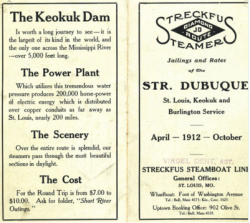Encyclopedia Dubuque
"Encyclopedia Dubuque is the online authority for all things Dubuque, written by the people who know the city best.”
Marshall Cohen—researcher and producer, CNN
Affiliated with the Local History Network of the State Historical Society of Iowa, and the Iowa Museum Association.
STRECKFUS STEAMBOAT LINE: Difference between revisions
No edit summary |
No edit summary |
||
| Line 3: | Line 3: | ||
By the turn of the century, Streckfus recognized the impact of railroads on the shipping trade. To reduce losses, he reorganized his company. He maintained a few packet boats but concentrated on establishing an excursion trade. (2) He took his fleet of ship to southern waters in the winter and returned them to the Upper Mississippi and the Illinois River during the summer. (3) | By the turn of the century, Streckfus recognized the impact of railroads on the shipping trade. To reduce losses, he reorganized his company. He maintained a few packet boats but concentrated on establishing an excursion trade. (2) He took his fleet of ship to southern waters in the winter and returned them to the Upper Mississippi and the Illinois River during the summer. (3) | ||
[[Image:jscard.png|left|thumb|250px|]]Streckfus was also an innovator. His "City of Winona" carried the first calliope. The first system of incandescent and arc lighting whose current was generated from one dynamo was installed on his "Verne Swain." The "J. S." carried the first soda water fountain, telephone system, and running water. (4) | [[Image:jscard.png|left|thumb|250px|The famed "J. S."]]Streckfus was also an innovator. His "City of Winona" carried the first calliope. The first system of incandescent and arc lighting whose current was generated from one dynamo was installed on his "Verne Swain." The "J. S." carried the first soda water fountain, telephone system, and running water. (4) | ||
On February 3, 1911 the [[DIAMOND JO LINE]] was sold to the Streckfus Company of Rock Island. For $200,000 the Streckfus Company obtained the steamers St. Paul, Quincy, Dubuque and Sidney. In addition it received the wharves, warehouses and boatyards of the company. The price was considered low. (5) According to reports at the time neither the St. Paul nor Quincy could be duplicated for less than $85,000. The deal also included fifteen landing places, valuable terminal property in Rock Island and Dubuque, and a wharf leased for twenty-five years in St. Paul and five dollars annually. (6) | On February 3, 1911 the [[DIAMOND JO LINE]] was sold to the Streckfus Company of Rock Island. For $200,000 the Streckfus Company obtained the steamers St. Paul, Quincy, Dubuque and Sidney. In addition it received the wharves, warehouses and boatyards of the company. The price was considered low. (5) According to reports at the time neither the St. Paul nor Quincy could be duplicated for less than $85,000. The deal also included fifteen landing places, valuable terminal property in Rock Island and Dubuque, and a wharf leased for twenty-five years in St. Paul and five dollars annually. (6) | ||
Revision as of 02:41, 18 February 2019
STRECKFUS STEAMBOAT LINE. In 1884 Captain John Streckfus, Sr. established the Acme Packet Company. Located in Rock Island, Illinois, the company had a small fleet of packet boats used for shipping freight and passengers along the MISSISSIPPI RIVER from Rock Island to Clinton. He pioneered that trade and later added the city of Winona, Minnesota to his routes. (1)
By the turn of the century, Streckfus recognized the impact of railroads on the shipping trade. To reduce losses, he reorganized his company. He maintained a few packet boats but concentrated on establishing an excursion trade. (2) He took his fleet of ship to southern waters in the winter and returned them to the Upper Mississippi and the Illinois River during the summer. (3)
Streckfus was also an innovator. His "City of Winona" carried the first calliope. The first system of incandescent and arc lighting whose current was generated from one dynamo was installed on his "Verne Swain." The "J. S." carried the first soda water fountain, telephone system, and running water. (4)
On February 3, 1911 the DIAMOND JO LINE was sold to the Streckfus Company of Rock Island. For $200,000 the Streckfus Company obtained the steamers St. Paul, Quincy, Dubuque and Sidney. In addition it received the wharves, warehouses and boatyards of the company. The price was considered low. (5) According to reports at the time neither the St. Paul nor Quincy could be duplicated for less than $85,000. The deal also included fifteen landing places, valuable terminal property in Rock Island and Dubuque, and a wharf leased for twenty-five years in St. Paul and five dollars annually. (6)
The Streckfus Company announced that it intended to remodel the Sidney into a first class excursion boat to take the place of the J. S. which was destroyed by fire near Trempealeau, Wisconsin during the summer of 1910. The Sidney was to be ready for the excursion season beginning on May 1st. As the renamed "J. S. "Deluxe", it operated between Peoria and St. Paul during the summer and south at New Orleans during the winter. The other three steamers were refitted and placed into regular packet trade between St. Louis and St. Paul during the summer and St. Louis to New Orleans during the winter. While general offices of the new company remained in St. Louis, it was announced that Dubuque would remain important since it was a midway point between there and St. Paul. (7)
---
Source:
1. "Diamond Jo Deal Not Yet Completed," Dubuque Telegraph-Herald, February 5, 1911, p. 9
2. www.jstor.org/stable/779421
3. "Diamond Jo Deal.."
4. "The Story of Jno. Streckfus' Rise," Dubuque Telegraph-Herald, August 13, 1911, p. 5
5. "Sale of Diamond Jo Line; $200,000," Dubuque Herald, February 12, 1911, p. 8
6. Ibid.
7. www.jstor.org/stable/779421



